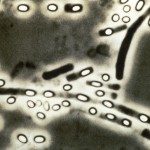Lien vers Pubmed [PMID] – 22253596
PLoS Pathog. 2012 Jan;8(1):e1002481
NK cells are important immune effectors for preventing microbial invasion and dissemination, through natural cytotoxicity and cytokine secretion. Bacillus anthracis spores can efficiently drive IFN-γ production by NK cells. The present study provides insights into the mechanisms of cytokine and cellular signaling that underlie the process of NK-cell activation by B. anthracis and the bacterial strategies to subvert and evade this response. Infection with non-toxigenic encapsulated B. anthracis induced recruitment of NK cells and macrophages into the mouse draining lymph node. Production of edema (ET) or lethal (LT) toxin during infection impaired this cellular recruitment. NK cell depletion led to accelerated systemic bacterial dissemination. IFN-γ production by NK cells in response to B. anthracis spores was: i) contact-dependent through RAE-1-NKG2D interaction with macrophages; ii) IL-12, IL-18, and IL-15-dependent, where IL-12 played a key role and regulated both NK cell and macrophage activation; and iii) required IL-18 for only an initial short time window. B. anthracis toxins subverted both NK cell essential functions. ET and LT disrupted IFN-γ production through different mechanisms. LT acted both on macrophages and NK cells, whereas ET mainly affected macrophages and did not alter NK cell capacity of IFN-γ secretion. In contrast, ET and LT inhibited the natural cytotoxicity function of NK cells, both in vitro and in vivo. The subverting action of ET thus led to dissociation in NK cell function and blocked natural cytotoxicity without affecting IFN-γ secretion. The high efficiency of this process stresses the impact that this toxin may exert in anthrax pathogenesis, and highlights a potential usefulness for controlling excessive cytotoxic responses in immunopathological diseases. Our findings therefore exemplify the delicate balance between bacterial stimulation and evasion strategies. This highlights the potential implication of the crosstalk between host innate defences and B. anthracis in initial anthrax control mechanisms.


